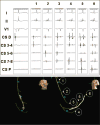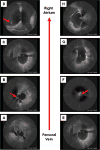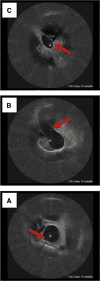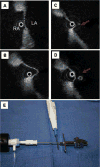Catheter ablation of atrial fibrillation without fluoroscopy using intracardiac echocardiography and electroanatomic mapping
- PMID: 20009075
- PMCID: PMC4570247
- DOI: 10.1161/CIRCEP.109.872093
Catheter ablation of atrial fibrillation without fluoroscopy using intracardiac echocardiography and electroanatomic mapping
Abstract
Background: Catheter ablation of atrial fibrillation is currently guided by x-ray fluoroscopy. The associated radiation risk to patients and medical staff may be significant. We report an atrial fibrillation ablation technique using intracardiac echocardiography (ICE) and electroanatomic mapping without fluoroscopy.
Methods and results: Twenty-one patients with atrial fibrillation (age, 42 to 73 years; 14 male; 14 paroxysmal, 7 persistent; body mass index, 26 to 38) underwent ablation. A decapolar catheter was advanced through the left subclavian vein until stable coronary sinus electrograms appeared on all electrodes. Two 9F sheaths were advanced transfemorally over a guide wire to the right atrium. A rotational ICE catheter was advanced through a deflectable sheath. Double transseptal puncture was performed with ICE guidance and facilitated by electrocautery. A 3D MRI left atrial image was registered to the ostia of the pulmonary veins using ICE. Catheter ablation was performed using ICE and electroanatomic mapping navigation. In 19 cases, no fluoroscopy was used and the staff did not wear protective lead. In 2 cases, 2 to 16 minutes of fluoroscopy was used to assist transseptal puncture. Median procedure time was 208 (188 to 221) minutes; coronary sinus cannulation took 5 (2 to 26) minutes; double transseptal took 26 (17 to 40) minutes; left atrial ablation time was 103 (90 to 127) minutes. All patients underwent circumferential pulmonary vein ablation and 8 patients underwent additional left atrial ablation. There were no procedure-related complications.
Conclusions: Catheter ablation of atrial fibrillation without fluoroscopy is feasible and merits further attention. This technique may be especially helpful in preventing x-ray exposure in children, pregnant women, and obese patients undergoing left atrial ablation.
Figures





References
-
- McWilliams MJ, Tchou P. The use of a standard radiofrequency energy delivery system to facilitate transseptal puncture. J Cardiovasc Electrophysiol. 2009;20:238–240. - PubMed
-
- Mangrum JM, Mounsey JP, Kok LC, DiMarco JP, Haines DE. Intracardiac echocardiography-guided, anatomically based radiofrequency ablation of focal atrial fibrillation originating from pulmonary veins. J Am Coll Cardiol. 2002;39:1964–1972. - PubMed
-
- Helms A, West JJ, Patel A, Mounsey JP, DiMarco JP, Mangrum JM, Ferguson JD. Real-time rotational ICE imaging of the relationship of the ablation catheter tip and the esophagus during atrial fibrillation ablation. J Cardiovasc Electrophysiol. 2009;20:130–137. - PubMed
-
- Lickfett L, Mahesh M, Vasamreddy C, Bradley D, Jayam V, Eldadah Z, Dickfeld T, Kearney D, Dalal D, Luderitz B, Berger R, Calkins H. Radiation exposure during catheter ablation of atrial fibrillation. Circulation. 2004;110:3003–3010. - PubMed
-
- Limacher MC, Douglas PS, Germano G, Laskey WK, Lindsay BD, McKetty MH, Moore ME, Park JK, Prigent FM, Walsh MN. ACC expert consensus document: radiation safety in the practice of cardiology: American College of Cardiology. J Am Coll Cardiol. 1998;31:892–913. - PubMed
MeSH terms
Grants and funding
LinkOut - more resources
Full Text Sources
Medical

